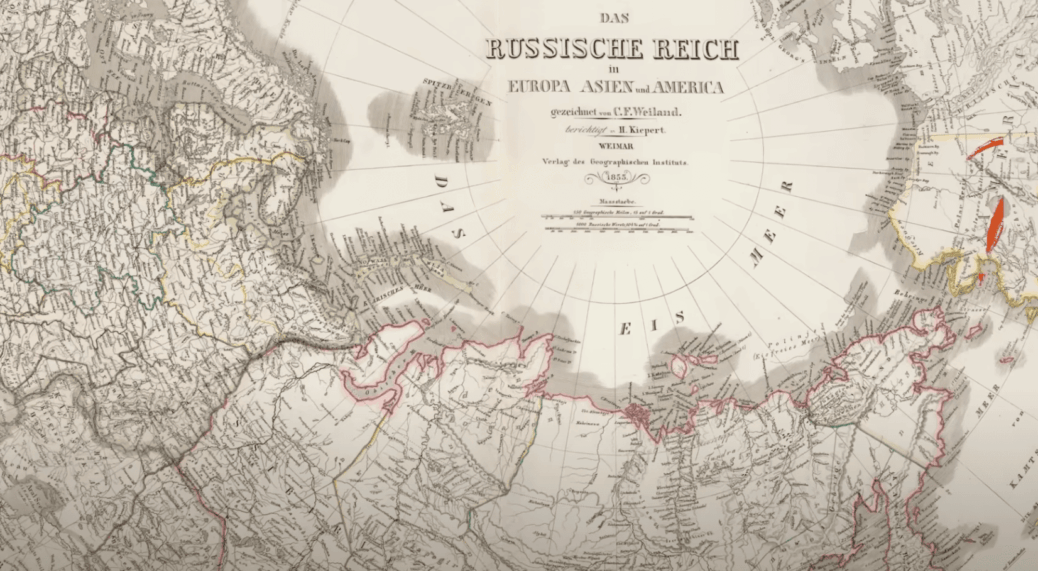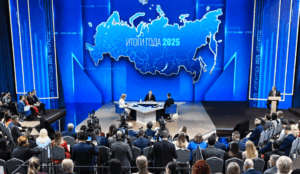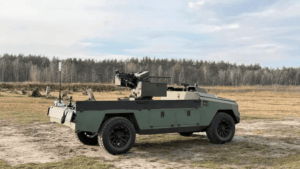Why did Russia sell Alaska? Was it really a 99-year lease? Who exactly sold Alaska to the United States – and why? WAS: Popular history‘s video explores the most mythologized deal of the Russian Empire: how and why Emperor Alexander II sold a territory that is now a strategically important part of the United States – Alaska.
From Catherine II to the “99-year lease,” from the gold rush to American military bases — we debunk the main myths about Alaska and show how this land became key in the geopolitics of the Arctic. And also — does Putin really want to reclaim Alaska?
Alaska is almost three times the size of Ukraine, with a population of only 700,000. Most of the territory has a harsh Arctic climate, with winter temperatures reaching minus 40, and short, though relatively snow-free, summers. Some say it was Empress Catherine the Great who sold Alaska to the United States – and not even sold, but leased it for 99 years. Then Brezhnev was supposed to get it back but forgot, because Stalin allegedly agreed during World War II not to touch Alaska in exchange for being “gifted” Eastern Europe. And earlier still, Lenin, as a crafty barterer, supposedly gave away the rights to Alaska in exchange for the lifting of the trade blockade.
Sounds like something from an alternate history textbook? That’s exactly what it is. Soviet and Russian propaganda never stop inventing geopolitical tales and urban legends for a domestically inexperienced audience — and as threats on the international stage. And as a bonus myth: Alaska is supposedly useless to America, just a suitcase without a handle, all subsidies and polar bears.
In this episode of WAS, we’ll debunk these and other myths about Alaska, its sale, development, and geopolitical significance — and also discuss what Alaska actually gives the United States and whether they made a mistake spending over 7 million dollars on it.
But before we start, please like this video, subscribe to our channel if you haven’t already, and hit the notification bell so you don’t miss our new episodes.
The first Russian expedition, led by Mikhail Gvozdyov and Ivan Fyodorov, landed in Alaska in 1732. The Russians immediately noted the large populations of fur-bearing and marine animals. By the 1780s, two Russian commercial companies were already operating there, with the most valuable animal for them being what was then called the sea beaver — the sea otter.
However, Empress Catherine the Great had no interest in Alaska at all; she even refused a loan for an expedition to explore and annex these North American lands. Catherine died 71 years before the agreement with the United States. Instead, her son, Emperor Paul I, took an interest in Alaska. He established the semi-private state-owned Russian-American Company (RAC), which was granted control over Alaska and the Aleutian Islands, along with exclusive rights to trade, hunting, and navigation in the northern Pacific Ocean.
Thus, Alaska became a Russian possession. The RAC combined commercial and state functions. Its activities were closely tied to the interests of the state, and for this reason alone, service to the company was considered service to the homeland.
The conquest of new lands came with great difficulties. At first, colonists suffered a high mortality rate from scurvy. Relations with the local population were poor: while the Aleuts accepted Russian rule relatively calmly, the Tlingit and Eyak tribes put up fierce resistance to the colonizers. During the Russian–Indian War, the Indigenous people burned several Russian settlements, including the colony’s capital — Fort St. Michael. The Russians retaliated, and by the end of the war, the Indigenous population in the territories under imperial control had decreased by one-third.
Thanks to the energy and enterprise of the first governor-manager, Aleksandr Baranov, the Russian-American Company grew stronger and gradually came to an understanding with the Indigenous peoples, greatly aided by their conversion to Christianity. By 1819, 15 settlements had been founded on the islands and the mainland. However, the actual Russian population did not exceed 2,500 people, while the Indigenous population was around 60,000.
The RAC introduced its own ersatz money: pieces of tanned seal skin, dyed in different colors, stamped with the company’s seal and marked with the denomination. After the enterprising Baranov retired, the RAC began appointing naval officers rather than businessmen as its managers. For example, right after Baranov, Alaska was governed for two years by Captain Second Rank Semyon Yankovsky, a native of the Ukrainian city of Hlukhiv. But naval captains had little understanding of trade with the Indigenous peoples, which was the basis of the company’s prosperity. Populations of valuable animals greatly declined due to intensive hunting, while corruption increased. The RAC suffered losses, and the development of Alaska slowed considerably.
In the 1830s, the Russians encountered numerous American traders and a powerful competitor — the British Hudson’s Bay Company. Taking advantage of the RAC’s weakness, Americans and Britons often operated in its territories as they pleased. The RAC was forced to lease part of its holdings in exchange for food supplies. Overall, the Russian position in Alaska was quite unstable. Toward the end of Nicholas I’s reign, the Governor-General of Eastern Siberia, Muravyov-Amurskyy, submitted a lengthy report to the Tsar, in which he noted: “It is clear that sooner or later we will have to give up our North American possessions.”
The Emperor heeded these arguments and ordered efforts to focus on developing Sakhalin. And it was during Nicholas I’s reign that the first — albeit fictitious — sale of Alaska took place.
During the Crimean War, fought between Russia on one side and the Ottoman Empire, Great Britain, France, and the Kingdom of Sardinia on the other, hostilities actually occurred in many regions. In the Pacific, the British and French forced the Russians to abandon Petropavlovsk-Kamchatsky, revealing that Russia’s possessions in America were completely undefended.
Faced with this situation, Russia urgently approached the United States with a proposal for a fictitious purchase-and-sale agreement covering all the Russian-American Company’s movable and immovable property, as well as its lands and estates, for a term of three years. In such a case, an attack by the British or French on Russian settlements in Alaska would have meant drawing the United States into the war.
The Americans, unhappy about a potential strengthening of Britain’s position in the region, agreed. At the same time, thanks to the close ties between the RAC and the Hudson’s Bay Company, the anti-Russian coalition never actually made a move on Alaska. The heads of the two companies agreed on a mutual neutrality between Russian and British possessions in America.
After the war, Russia was in urgent need of funds, and the Americans proposed to sell Alaska for real this time. At that time, the United States was actively settling the Pacific coast and had a territorial dispute with Great Britain over Oregon. Alaska gave the Americans the opportunity to control much of the Pacific coastline.
In Saint Petersburg, at a secret meeting with the new Emperor Alexander II, the issue was discussed by Grand Duke Konstantin Nikolayevich, the ministers of finance and the navy, and the Russian envoy to Washington, Eduard Stoeckl. These men concluded that ceding Russian possessions in America to the United States was highly desirable for several reasons:
First, selling Alaska to the Americans would weaken British power in North America, intensify Anglo-American tensions, and strengthen relations between Russia and the United States.
Second, with the consolidation of Russian control over the Amur and Primorye regions, Alaska no longer held strategic importance for Russia.
Third, after 70 years, Russia had failed to Russify the local population or properly colonize the territory, and the Russian-American Company’s debts to the state budget amounted to as much as 725,000 rubles.
And finally, selling Alaska freed Russia from owning a territory it would be unable to defend in case of war.
During negotiations between U.S. Secretary of State William Henry Seward and Russian Ambassador Eduard Stoeckl, they agreed on a price of $7,200,000. It should be noted that there was considerable opposition in the U.S. to purchasing such a vast, undeveloped territory. Many believed the only value in Alaska was its wild animals. Moreover, the United States had just emerged from a bloody Civil War, so there were already plenty of problems without Alaska.
The U.S. Senate ratified the treaty by a narrow margin. The treaty was signed on March 30, 1867, in Washington, and later ratified by the Emperor.
A legend says that the treaty was supposed to include the phrase “на век” (meaning “for a century”), but due to a mistake, it was written as “навек” (meaning “forever”), and that is why Russia lost Alaska permanently. However, this legend does not hold up to scrutiny.
Firstly, the treaty was written in English and French. There is, of course, a Russian version publicly available, titled “Highest Ratified Convention on the Cession to the United States of America of the Russian North American Colonies”, and it does not contain the word or phrase “навек” at all. We have included a link in the video description so you can check for yourself.
Thus, the myths about Lenin, Stalin, and Brezhnev supposedly using or neglecting Russia’s rights to Alaska in negotiations have no basis, because Alaska was sold permanently.
The subsequent course of events confirmed at least one of the arguments made by Russian supporters of selling Alaska: the Russo-Japanese War revealed the Russian Empire’s inability to defend its Pacific frontiers. By the way, that war ended thanks to U.S. mediation. To learn more about how this happened, as well as about other complex peace negotiations, watch our video — the link is in the description.
About three decades after the purchase agreement, valuable mineral deposits were discovered in Alaska, sparking a gold rush. During that period, approximately 360 tons of gold were mined in Alaska. The gold deposit known as Fort Knox, near the city of Fairbanks, is still considered the largest in the United States. Overall, in nearly 140 years, more than 1,500 tons of gold have been extracted from Alaska.
Friends, you know that history won’t tell itself, so supporting “WAS” is a great idea — all the ways to do so are in the description. And to those who have already supported us, thank you from the bottom of our hearts. Illia Maier, Andriy Skoropad, Vadym Makarenko, Oleksiy Rudenko, Ostap Honchar, Kateryna Plekhova, Vlodko Humenyuk, Sergiy, Alexander Pochkun, Maksym Shpak, Dmytro Ishchenko, Margaryta Kremneva, Viktor Dorohiy, Yelyzaveta Hlotova, Denys Sobol.
Since the start of the full-scale war against Ukraine, Russia’s top officials have repeatedly made statements suggesting that the sale of Alaska could be reconsidered.
“America should always remember: there is a part of Russian territory — Alaska. We also have something to reclaim!” — Vyacheslav Volodin, Chairman of the State Duma of the Russian Federation, July 6, 2022.
Of course, Russia now eyes Alaska hungrily, since Americans utilize the territory far more effectively than the Russians ever did. Alaska has made a significant contribution to the U.S. economy thanks to its abundant natural resources, especially in the oil and gas sector.
After the discovery of the Prudhoe Bay oil field and the launch of the Trans-Alaska Pipeline, the state experienced an oil boom. At its peak, Alaska produced over 2 million barrels of oil per day and was the largest oil-producing state in the U.S. It is estimated that over the past half-century, Alaska’s oil and gas industry has generated more than $180 billion in revenue. Thanks to these earnings, state residents receive annual dividends.
Alaska is also a key supplier of fish, accounting for up to two-thirds of all marine commercial catches in the U.S. Alaska’s real GDP in 2025 is roughly $70 billion. The state ranks ninth in the country in income per capita.
However, with a small population and vast territory, Alaska’s annual federal expenditures per resident are the highest – about $9,000 per person. These subsidies cover road construction, airports, communications, and air travel support. Russia would hardly have such opportunities for development and revenue generation from natural resources.
For comparison, just across the Bering Strait from Alaska lies Chukotka – a poor, almost infrastructure-free region.
From a geopolitical perspective, Alaska is one of the most strategically important places on Earth for the Americans, since it is located closer to many world capitals than most U.S. states. This means forces stationed in Alaska can quickly reach Europe or Asia via polar routes.
During the Cold War, Alaska was a frontline outpost against the USSR. In the 1950s, a network of early warning radars was deployed here to track Soviet bombers. Today, Alaska hosts the headquarters of the 11th Air Force, units of the North American Aerospace Defense Command (NORAD), radar installations, an anti-missile defense complex, and key military bases such as Elmendorf-Richardson, Fort Wainwright, Clear, and Eielson.
In recent years, the Pentagon has invested billions of dollars in upgrading airfields and ports. In effect, Alaska has become a shield against a potential attack from the north and a platform for deterrence forces in the Pacific.
Alaska makes the United States an Arctic nation. Through Alaska, Americans gained not only access to the Arctic Ocean but also rights to an exclusive economic zone in the Arctic. This provides access to resources such as offshore oil and gas and allows the use of advantageous sea routes. Without this, Russia would dominate the region completely.
Alaska is bordered by the Bering Strait – a narrow passage between the Pacific and Arctic Oceans — giving the U.S. the ability to control movement between the two oceans. The U.S. also maintains military forces on the Aleutian Islands, protecting trade routes and territory on the far approaches.
Therefore, the purchase of Alaska in 1867 was undoubtedly a farsighted move. It prevented the emergence of Soviet territory in North America and secured the U.S. status as a major Arctic power.
But will the United States continue territorial expansion in the 21st century by buying lands?
























